
Nucras is a genus of African lacertid lizards, commonly called sandveld lizards.

Ophisops is a genus of wall lizards of the family Lacertidae. They are small lacertids characterized by transparent lower eyelids that are completely or partially fused with the upper lids to form a cap over the eye. Species of the genus Ophisops are distributed in southeast Europe, northeast Africa, to west Asia.
Colonel Richard Henry Beddome was a British military officer and naturalist in India, who became chief conservator of the Madras Forest Department. In the mid-19th century, he extensively surveyed several remote and then-unexplored hill ranges in Sri Lanka and south India, including those in the Eastern Ghats such as Yelandur, Kollegal, Shevaroy Hills, Yelagiri, Nallamala Hills, Visakhapatnam hills, and the Western Ghats such as Nilgiri hills, Anaimalai hills, Agasthyamalai Hills and Kudremukh. He described many species of plants, amphibians, and reptiles from southern India and Sri Lanka, and several species from this region described by others bear his name.

Saara hardwickii, commonly known as Hardwicke's spiny-tailed lizard or the Indian spiny-tailed lizard is a species of lizard in the family Agamidae. The species is found in patches across the Thar desert, Kutch, and surrounding arid zones in India and Pakistan. It is mainly herbivorous and lives in numbers in some areas. Since it is found in loose clusters it often attracts predators such as raptors. It is also hunted by local peoples in the belief that the fat extracted from it is an aphrodisiac.

Ophisops beddomei, commonly known as Beddome's snake-eye or Beddome’ s lacerta, is a species of lizard in the family Lacertidae. The is a diurnal and fast-moving terrestrial lizard, that is endemic to the Western Ghats of India.

Ophisops elegans, commonly known as the snake-eyed lizard, is a species of lizard in the family Lacertidae. The species is endemic to the Mediterranean region and Central Asia. There are nine recognized subspecies.

Ophisops jerdonii, commonly known as Jerdon's cabrita, Jerdon's snake-eye, or Punjab snake-eyed lacerta, is a species of lacertid lizard, which is distributed in east Afghanistan, Pakistan, and India.

Ophisops leschenaultii, commonly called Leschenault's snake-eye, Leschenault’s lacerta, or Leschenault's cabrita, is a species of lacertid lizard endemic to India and eastern Sri Lanka. In Sri Lanka, this lizard is called Pandura katussa in Sinhala. In some parts of the country, it is also called Heeraluwa or sikanala, which is more common name for all skink-like reptiles.
Ophisops microlepis, the small-scaled lacerta, is a species of lizards found in parts of India.
Ophisops nictans, the lesser snake-eyed lacerta, is a species of lizard found in Sri Lanka and India.

Coelognathus helena monticollaris is subspecies of a nonvenomous constricting snake in the family Colubridae. The subspecies is native to south Central Asia.
Ophisops occidentalis, the western snake-eyed lizard is a species of lizard in the family Lacertidae. It is found in Algeria, Egypt, Libya, Morocco, and Tunisia. Its natural habitats are temperate forest, Mediterranean-type shrubby vegetation, subtropical or tropical dry lowland grassland, and rocky areas. It is threatened by habitat loss.
Ophisops elbaensis, the Mount Elba snake-eyed lizard, is a wall lizard in the family of true lizards (Lacertidae). It is found in Sudan, Egypt, Saudi Arabia, and Yemen.
Ophisops pushkarensis, the Pushkar small-scaled snake-eye, is a wall lizard in the family of true lizards (Lacertidae). It is endemic to India.







